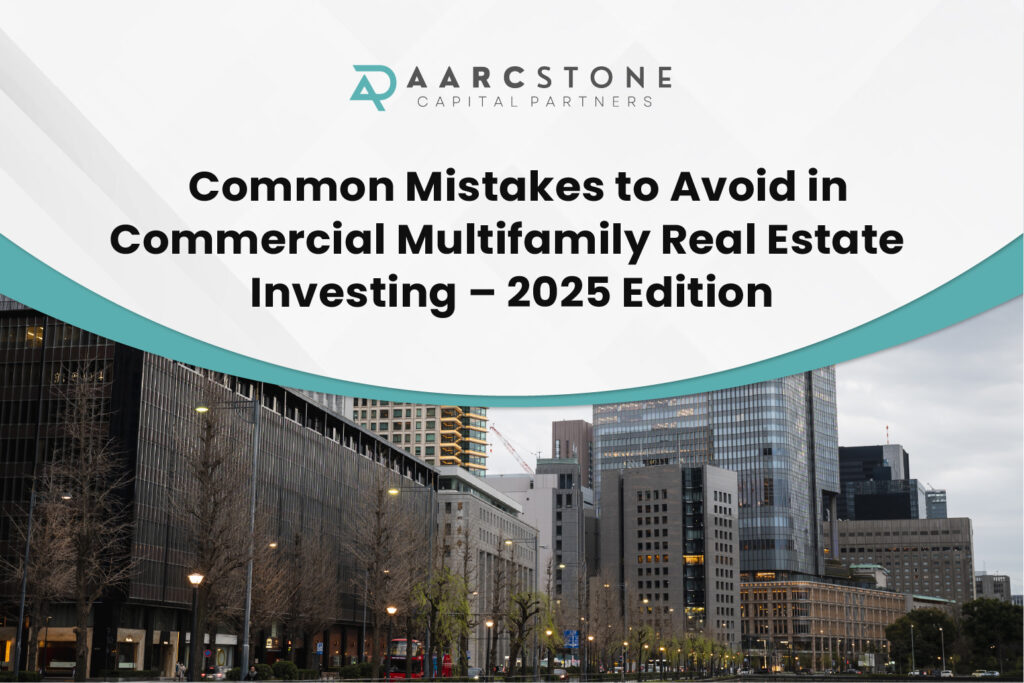
Introduction
Commercial multifamily—defined as properties with five or more residential units—remains one of the most resilient real estate sectors in 2025. U.S. vacancy rates are projected at 4.9% with national rent growth forecast around 2.6% (Source: CBRE, U.S. Multifamily Market Outlook 2025).
In an environment of elevated borrowing costs, shifting regional fundamentals, and increased operational expenses, avoiding costly mistakes is critical to maintaining NOI and maximizing long-term returns. Below are the eight most common—and avoidable—errors in today’s market, along with strategies backed by current data and real transaction outcomes.
1. Neglecting Submarket-Level Research
Mistake: Relying on national or metro-level stats without analyzing submarket absorption, rent trends, and competitive pipeline.
Why It Matters: A metro like Dallas–Fort Worth may show strong overall demand, but certain submarkets—like Frisco—face 3,000+ units delivering in the next 12 months, pushing vacancy risk above metro averages.
How to Avoid:
- Compare 12-month absorption vs. deliveries in your target submarket (Source: Cushman & Wakefield, Multifamily MarketBeat Q2 2025).
- Target employment-rich corridors with limited land availability and restrictive zoning.
2. Miscalculating Net Operating Income (NOI)
Mistake: Inflated rent growth assumptions or underestimated expense loads.
2025 Baseline: Stabilized operating expenses average 38–45% of Effective Gross Income nationally (Source: Marcus & Millichap, 2025 U.S. Multifamily Investment Forecast).
Real Example: In 2024, an Aarcstone client acquired a 212-unit asset in the Midwest. Original underwriting assumed a 34% expense ratio. Our due diligence adjusted it to 42% after factoring in higher insurance and payroll. This saved the buyer from a projected $280K annual NOI shortfall.
3. Overleveraging
Mistake: Maximizing loan proceeds without considering DSCR compliance or refinance risk.
Lender Snapshot (2025): Agency lenders are holding to DSCR ≥ 1.25 and LTV ≤ 65–70% for transitional assets (Source: Freddie Mac Multifamily Outlook 2025).
Regional Note: Sun Belt markets with high rent growth volatility (e.g., Austin) require more conservative leverage to weather lease-up risk.
4. Skipping Comprehensive Due Diligence
Mistake: Rushing to close without full physical, financial, and legal vetting.
Key 2025 Risks:
- Deferred CapEx (HVAC replacements, roofs, plumbing risers)
- Environmental liabilities in legacy industrial conversion sites
- Tenant file inconsistencies affecting income verification
Case Example: In 2023, a Houston investor discovered $1.2M in unbudgeted roof and chiller system replacements post-close—costs that would have been flagged in a Property Condition Assessment (PCA).
5. Underestimating Insurance & Property Tax Impact
Mistake: Using seller’s historical costs without modeling post-sale adjustments.
2025 Data: Coastal and severe-weather states are seeing 20–40% annual insurance premium increases; property taxes often reassessed at purchase price (Source: CBRE, 2025 Outlook).
Regional Insight: Florida and Texas assets should be underwritten with +25% insurance cushion and full tax reassessment at sale.
6. Weak Property Management Oversight
Mistake: Delegating without setting clear performance KPIs.
Best Practices:
- Occupancy > 95%
- Economic occupancy within 1–2% of physical occupancy
- Delinquency < 2%
- Average work order completion < 3 days
Visual Insight: In 2024, assets with <3-day work order completion averaged 1.8% higher renewal rates (Source: NMHC Operations Benchmarking Report).
7. Ignoring Exit Strategy Planning
Mistake: Buying without modeling multiple exit scenarios.
Why It Matters in 2025: With cap rate spreads to Treasuries narrowing, exit timing can swing IRR by 200–300 bps.
Pro Tip: Build in prepayment flexibility (e.g., step-down yield maintenance) for potential mid-cycle sale or refinance.
8. Skimping on Contingency Reserves
Mistake: Deploying all equity to acquisition without reserves.
2025 Recommendation: Maintain 6–12 months of operating expenses in reserve, especially in markets facing supply surges.
Example: An Indianapolis owner avoided a capital call in 2024 by using reserves to offset a 9% vacancy spike during a competing lease-up. By holding through stabilization, they exited at a full $1.3M above 2023 appraised value.
Conclusion
In 2025’s multifamily real estate investment market, success is about precision—in underwriting, asset management, and market selection. By anchoring decisions in submarket-specific data, maintaining conservative capital structures, and executing disciplined due diligence, investors can protect downside risk while positioning for NOI growth and asset appreciation.
